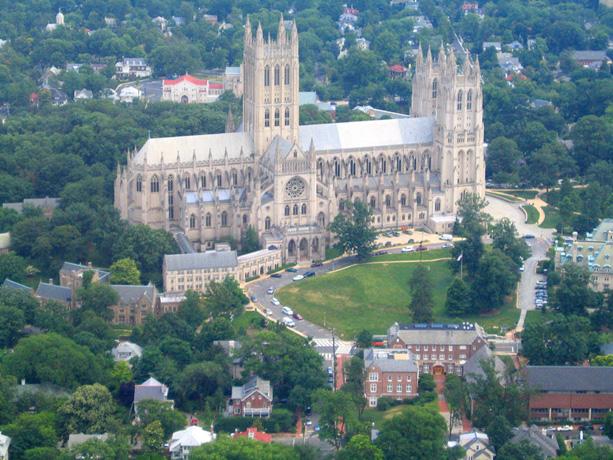When Pierre l’Enfant drew his plan for the City of Washington, it included a “national church,” which he thought should be built on the site where the National Portrait Gallery now sits. It wasn’t until 100 years later that Congress approved a plan for the Episcopal Cathedral Foundation to proceed with fundraising and then construction, which began in 1907, to the national church that was formally named the Cathedral Church of Saint Peter and Saint Paul. They chose a high point in the city, Mount St. Albans, and even though the cathedral is the third highest structure in Washington at 301 feet, its position on a hill 400 feet above sea level makes it tower over all other structures in the city.
The National Cathedral is reputed to be the sixth largest cathedral in the world. In the U.S., it is second only in size to the Cathedral of St. John the Divine in New York City.
Like the great cathedrals of Europe, it took a long time to build: in this case, some 83 years. And, like the cathedrals of the Middle Ages, flaws were purposely built into the construction, some say as an admission on the part of the builders that only God could be perfect, a kind of mea culpa for the vanity of such a creation. Yet these intentional flaws actually served to make up for visual distortions, a device that even the builders of the great pyramids of Egypt employed. For example, the main aisle of the cathedral where it meets the cross section is tilted slightly off its axis to make up for the visual distortion that would occur if when one were to stand in the middle of the aisle and look down the long expanse. In further reference to the great medieval builders, the architects of the National Cathedral included crypt chapels in the Norman, Romanesque and Transitional style, a mixture that also occurred in the great Gothic cathedrals of Europe where construction took so long that many changing style elements were blended in the same cathedral.
When we think of these mixed styles, is natural to think of the two very different towers on the great cathedral of Chartres in France. However, that particular cathedral that we see on the site was built quickly, as medieval cathedrals go. The reason for the two different towers is because one of the original matching 12th century towers was struck by lightening some four centuries after it was built. When it was replaced, the ornate Flamboyant gothic style was all the rage, and so the new tower was very different from the other simpler Romanesque tower. Like Chartres, the great permanence that the National Cathedral represents was tried in a similar way, when the 5.8-magnitude earthquake of 2011 shook the building and caused damage that will take many years and some 26 million dollars to repair.
Medieval cathedrals were compendiums of the civilization they represented, and much like Chartres, the National Cathedral is full of symbolism, both religious and artistic. Its decorations, architecture and its 200 stained glass windows can be “read” like a book. Students of Western culture will do well to add the National Cathedral to their list of art museums, as one more great place in our city to visit and learn.
Donna Evers, devers@eversco.com, is the owner and broker of Evers & Co. Real Estate, the largest woman-owned and run residential real estate company in the Washington Metro area, the proprietor of historic Twin Oaks Tavern Winery in Bluemont, Va., and a devoted student of Washington history.


